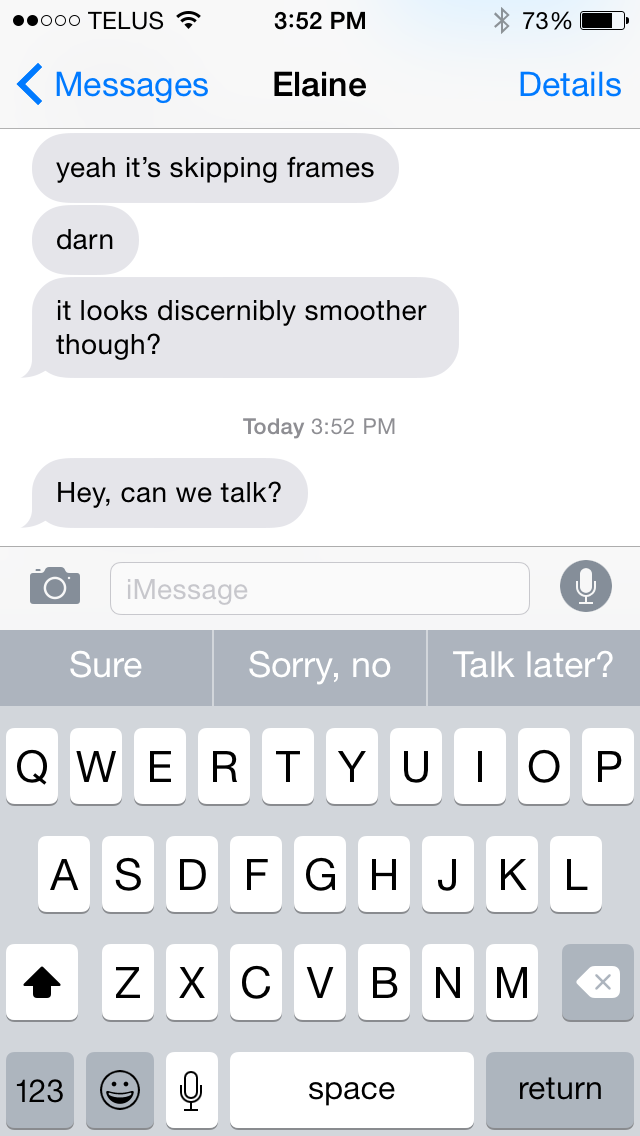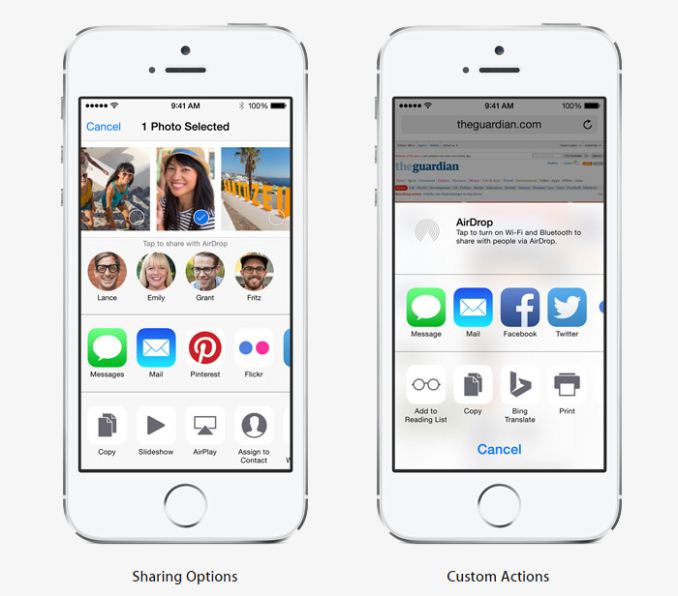The iOS 8 Review
by Brandon Chester on September 17, 2014 1:00 PM ESTKeyboard
For a long time the keyboard experience on iOS remained the same as it was when the original iPhone launched all the way back in 2007. With iOS 7 the keyboard received a visual overhaul, but the layout and correction functions remained the same. This has been a prominent criticism of the stock iOS keyboard over the years, with the single suggestion implementation of iOS's autocorrect seeming archaic compared to other smartphone keyboards. Apple addresses this with two solutions in iOS 8. The first is QuickType, Apple's new suggestion and correction feature.
The above two images will be instantly recognizable to anyone who has used the Google keyboard for Android, or third party keyboards like SwiftKey. The way quicktype functions is nearly identical to the suggestion feature on Google's and other smartphone keyboards. A bar above the keyboard gives three suggestions as the user types, with the box turning white and the text turning blue to indicate that a typed word will be autocorrected.
QuickType is not Apple's only solution to complaints about the iOS keyboard. While it offers a better method of correcting typos, the keyboard itself is still functionally identical to its predecessor. Because Apple can't possibly hope to address every single user's desire for keyboard input on their own, they have finally included the long requested ability to use third party keyboards on iOS 8. How keyboards and other extensibility options are implemented is discussed in the next section, but there are a couple of things specific to third party keyboards that should be noted.
The first is that third party keyboards will be system wide; there's no need for developers to implement them in their applications on their own. The second, and possibly most important, is that third party keyboards run in an extremely restrictive sandbox by default. They don't have access to the information from other applications on the phone, or access to WiFi or cellular networks. However, third party keyboards can ask for access to typed words and networking to do prediction, but for privacy and security reasons that is never something that can be enabled by default. I recently took a look at the beta version of SwiftKey for iOS 8, and you can read my impressions about the actual third party keyboard experience on iOS there.
One last point about the stock keyboard. The shift key is the same as on iOS 7.1. Users (like myself) that are frustrated with its new design as of iOS 7.1 are out of luck. A return to the iOS 7 style of having the shift key arrow as an outline when it is turned off is my biggest recommendation for improving the iOS keyboard from its current state.
Extensibility
When the iPhone was first launched, iOS wasn't even designed to support third party applications. Apple's original stated intent was that users would use web apps through Safari. Obviously things turned out quite differently with the introduction of iOS 2.0 and the App Store. However, iOS itself was never conceived with a massive library of native applications in mind. Because of that, and because of security reasons, each app has traditionally been completely segregated from all others.
Applications on iOS have never really had a proper way of sharing data and integrating with each other, with the exception of the select few services that Apple has built into iOS over the years like Facebook and Twitter. This has always posed a problem with working on files across multiple apps. It also greatly limits the ability to share content through other applications, as the iOS Share Sheet is limited to the services built into iOS unless a developer adds support for other applications on their own.
Extensibility changes this. Extensibility in iOS 8 is really an umbrella term for new features like share extensions, action extensions, custom photo filters, and document provider extensions. Some of these have been covered at other points in this review, and the parts being focused on here are Action Extensions and Share Extensions. Much like the improvements to iCloud, these are additions that are hard to talk about now as they are yet to be implemented by developers. This is just a small overview of things to come once developers start using the new tools given to them.
Action Extensions do what their name implies, they perform actions that extend the functions of applications. An example would be an extension for the Bing Translate app shown at WWDC. Rather than Apple having to work with Microsoft to make translation with Bing a system wide feature, Microsoft can simply make an Action Extension and have it appear in the Share Sheet in any application.
Share Extensions also do what their name implies. They allow applications to put their own options for sharing in the system's Share Sheet. This is a massive improvement over the previous system that only included limited options and the small handful of services that Apple had integrated into the OS like Twitter and Facebook. Share Extensions are very similar in function to how Intents are able to share files and content between different apps on Android, and it addresses what has been a major iOS shortfall for years. The example Apple gave at WWDC was the ability to open the Pinterest app interface within Safari to share a photo.
iOS also has contextual awareness relating to extensions. Because the Share Sheet can only display four icons in each row, only the extensions that relate to what the user is doing will be shown. If the user is looking at the photos application the Share Sheet won't show an extension for text translation as it doesn't relate to the task at hand. Apple also allows the order extensions are displayed in to be customized so that frequently used extensions are always displayed in the Share Sheet without having to scroll.
One final part of extensibility that pertains to iPhone 5s users is that developers are now able to use Touch ID authentication in their applications to unlock passwords stored as keychain items. The fingerprint data itself is never shared with applications, only whether or not the fingerprint was successfully identified or not.
As I said above, the iOS security model has always used application sandboxing to prevent malicious access to information. With extensibility you may be wondering if Apple has had to compromise on security to enable these new features. Fortunately, the answer is no. With the way extensions work on iOS 8, the extension is part of its parent application's container. Extensions can only reach out to other applications by way of the operating system, which has various checks and balances to make sure things are being done in a safe and secure manner. I don't believe users should have any concerns about the security of their devices when upgrading to iOS 8.













164 Comments
View All Comments
toluene - Thursday, September 18, 2014 - link
Powerlevels here are very low. They're from "Puella Magi Madoka Magica" from glorious studio SHAFT.Homura did nothing wrong.
SeleniumGlow - Friday, September 19, 2014 - link
True. Homura is innocent.But I'd kill to have those figurines... I want the kyuubi... They aren't available in my country at all.
jdrch - Thursday, September 18, 2014 - link
"I do wish that Apple would add the ability to link accounts from XMPP messaging services like you can with Messages on OS X. Having Messages become a central hub for Facebook, Hangouts, iMessage, and SMS would clear a number of applications off my phone."Yikes, AT ... Hangouts dropped support for XMPP when it succeeded GTalk. Pretty bad miss there.
Brandon Chester - Thursday, September 18, 2014 - link
Yes you're right. That should say Google Talk which is what can be added to Messages on OS X.Brandon Chester - Thursday, September 18, 2014 - link
Also it would be better worded to not specify as XMPP. I'll revise it as soon as I can.Murazlols - Friday, September 19, 2014 - link
I was about to install the new ios8 to my 4s. And i erased all my apps because the i only had 8gig. Then i heard the bad feedbacks about it. Now the problem is i cant download and install any apps i had before and i dont what the problem is :( does anyone here know how to fix it? I need help :(mikato - Friday, September 19, 2014 - link
Are they in your itunes still? You may have to connect your phone to whatever computer you have with itunes that you've synced to and check it out.Wolfpup - Friday, September 19, 2014 - link
Regarding upgrading the OS, there's no real choice unless you're only going to use the device as an ebook reader and for netflix, stuff like that that's not connecting to the Internet generally. No way is it safe to be using a device with an unsupported OS for things like browsing the web and email and the like.iOS 7 destroys podcast support on iOS (even though I had an iPhone 5s, I bought an iPod classic to use with it for podcasts, iOS is so bad at them now). But anyway performance on my iPad 2 was fine. Not as smooth as my 5s, but mostly just due to being massively RAM starved (which the 5s is too frankly).
Between 4 out of the 4 Lightning connector devices I've owned having the port go bad (even my 5s after 10 months of carefully babying it), and Windows tablets now being available at similar (even cheaper!) price points than dumbed down iOS tablets, I'm done with the OS for tablets until 1) Apple ditches Lightning for USB, and 2) Apple puts real OS X on a tablet...what they should have done to begin with. (Granted, that was far less practical in 2010 than it is today, but today? For crying out loud Toshiba just launched a $120 tablet running real Windows with as much RAM and storage as the best iOS devices, complete with a good CPU/GPU by tablet standards. Screen is junk sounds, but it's freaking $120)
JoyTech - Friday, September 19, 2014 - link
When are you guys publishing your iPhone 6 review?Comments - Saturday, September 20, 2014 - link
"Even under iOS 7.1, the UI smoothness on devices like the iPhone 4s and the iPad 2 is far from exceptional."I think Bradon is talking about a iPhone 4 here, because iOS 7.1 has always been very smooth on my iPhone 4s (iOS 8.0 is ok, but not fluent, hoping for improvement soon).